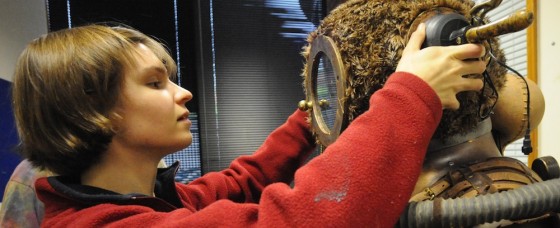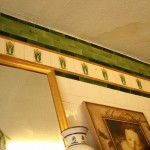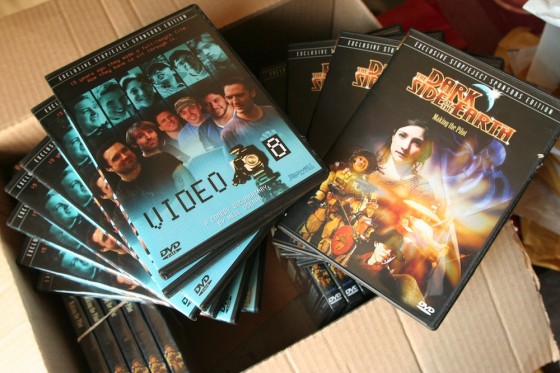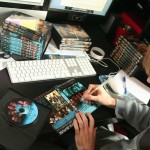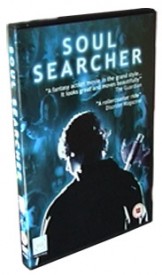
Everyone on the cast and crew probably wanted to kill me because of the schedule. The days were too long and the turnaround times were too short. But let’s look at how the schedule developed in pre-production and how it turned out in practice.
Before we begin, some basic info. The script is 19 pages long, so theoretically 19 minutes. There are 31 scenes, 11 story days and 14 locations. Yeah, in a nutshell, ridiculous for a short film.
Six of the locations we found in one building: Magpie, in Matlock. Most of the remaining ones were in Belper, 11 miles down the road.
When we were going to shoot last October, it was a four-and-a-half day schedule. The first half day we would have been without the lead actress (who is in almost every scene) and the last half day we would have been without anyone except a skeleton crew, for shooting close-ups of the tape recorder.
When the project got up and running again this year, I immediately increased the schedule to five days. I had been really freaked out in October about getting it all shot in essentially just four.
Initially I wanted to shoot Monday-Friday, since weekdays seemed most convenient for the locations, but the two lead actors we had at the time both temped during the week and wanted to do as much as possible at the weekend, so I went with Saturday-Wednesday. (Ironically, it would have better suited Georgie, who ultimately played the lead role, if we had shot Monday-Friday.)
Remember that the first and foremost goal of your schedule is to minimise the number of location moves, because they waste phenomenal amounts of time. (A common mistake is to consider only the driving time between locations and overlook the time it takes to derig all the equipment, pack it into the vehicles, unpack it and set it up again at the other end. And don’t forget that at least one of your vehicles will probably get lost during the location move, so budget in time for that as well.)

I knew that those of us who weren’t local to the area could stay at Magpie, and that we could also stay at Sophie’s in Belper from the third day onwards. So the most logical schedule was to shoot all the Magpie stuff Saturday-Monday, then move to Belper on Monday night and shoot everything there on Tuesday and Wednesday.
This was all well and good until Georgie was cast a week before the shoot, and she had a prior commitment in London on Sunday morning. This meant we would lose her at 7pm on Saturday and not get her back for 24 hours.
There was approximately a day’s worth of material that could be shot without her, but half of that consisted of tape recorder close-ups that couldn’t be filmed until we had her master shots to match them to, master shots from various locations that couldn’t possibly all be shot on Saturday. So it was clear that Sunday’s schedule would be pretty sparse until Georgie returned at 7pm, shooting just the Businessman scenes in Belper. The half-day of tape recorder close-ups would have to wait until Thursday, extending the schedule.
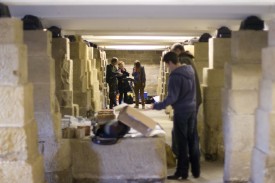
The other fixed point I was working around was the basement location (in Belper), which was only available on the Tuesday. This prevented me from simply flipping the schedule and doing all the Belper stuff first, then the Magpie stuff.
Two full days of shooting would take place on the shop floor of Magpie, and it was essential that those were consecutive so that we wouldn’t have to restore the shop and then redress it again later. Given the availability of Georgie and the basement, the only solid two-day stretch was from Sunday evening through to Tuesday lunchtime, which even then isn’t a full two days. So that’s where the shop floor had to go, and the rest of the schedule just had to fit around it.
Since many of us would be staying at Magpie over the weekend, I was keen to do as much filming there as possible during that time, so I scheduled in the living room, bedroom and nursing home scenes for Saturday. But then I realised that this left the major exterior scenes nowhere to go except Wednesday – the last day of the shoot. If the weather was bad, we would have nowhere left to postpone them to.
So the living room, bedroom and nursing home got moved to Wednesday and the exteriors slotted in on Saturday, with the proviso that they would be swapped back if Saturday was rainy.
I had arrived at a final schedule, which looked like this:
 Stop/Eject schedule download (.PDF, 157kb)
Stop/Eject schedule download (.PDF, 157kb)
As you can see, there are some tight turnarounds, particularly during the shop floor stuff in the middle of the schedule. This was partly a result of squeezing two days of shop floor material into one full day, one morning and one evening. It was also difficult to balance conflicting things like the need to wait for it to get dark at the end of the day to shoot some scenes, but also needing to get up early enough in the morning to film exteriors outside the shop when the road wasn’t too busy.
I definitely felt like I was fighting the clock throughout the shoot.
We wrapped more or less on time on Saturday, but had dropped the sun GVs and a crucial wide shot for the weir scene.
On Sunday things kept to schedule until the evening, when we overran and wrapped about 75 minutes late.
We wrapped most of the cast and crew slightly later than the anticipated time of 10:30pm on Monday, but Colin and I cracked through the cutaways and wrapped the day overall a few minutes early.
On Tuesday we finished at Magpie at noon, not 11am, but made up some of the time on the location move (which almost never happens) and got to the basement only half an hour late. We wrapped there still about 30 minutes behind, but made up the time at the cemetery. Then we got ahead of schedule by changing the bridge shot (scene 15) from night to day, thus saving an hour of setting up lights, and were able to retire to Sophie’s and get the kitchen scene in a very relaxed fashion.

Wednesday was without a doubt the toughest day. Although the living room, the bedroom, the nursing home and the alcove set were all in the same building, moving between them still took time, and since we were all fatigued it was like wading through treacle. By lunchtime we were two hours behind and this only got worse as we moved onto the critical alcove scenes after dinner. It must have been getting on for 3am by the time we wrapped.
Thursday turned out very differently to what we’d planned. Fortunately Georgie and Ollie were both available to pick up the weir wide shots. We started late because everyone was so knackered, and couldn’t shoot at the first location we visited (due to heavy rainfall swelling the river), so had to move to another one. We finally got the two shots in the can by about 3pm, and decided to leave most of the planned tape recorder close-ups to another time. (I’ll be shooting them here in Hereford next week.)
I’ll discuss why we kept falling behind schedule in a future post, but I’d like to end on a cautionary note. Not allowing sufficient turnaround time is a vicious circle. I hated the mornings on the shoot because I could see that people weren’t getting up fast enough to get out of the door at the necessary time. I couldn’t hassle them because they’d been up late the previous night and were understandably very tired, but I knew that by starting late we would end up finishing late again and the cycle would continue.
The only way to lengthen the turnaround time would have been to have added another day to the schedule, and this of course brings its own problems in the form of increased costs and people’s availability. This is why making unpaid short films will always be a messy, unpleasant business and if you’re at all rational you’d do well to avoid such shoots like the plague.
But where’s the fun in that?

